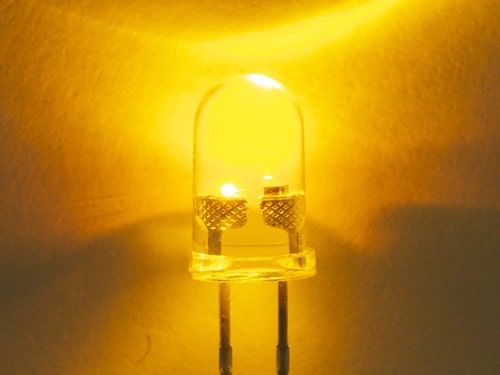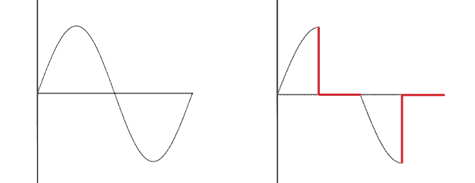If you have noticed your LED bulbs flickering and want to know why this nuisance, you have come to the right place. Flickering is a common problem in LEDs, and it can be quickly resolved as well. Several causes are involved in LED flickering, such as a bad LED driver, incompatible dimmer, low-quality bulb, or a reason as simple as loose wiring. So, sit back and read on.
Before heading to the causes of flickering, we shall tell you about the science behind the flickering. What is flickering? Does it have any adverse effect on your health? Does it decrease the life of LED bulb fixtures? Or should you be worried about the bulb exploding!
What is Flickering?
Flickering is the rapid blinking in the output light caused by the disturbing oscillations of the incoming power supply. These rapid oscillations can cause many health issues in people exposed to such lighting. Moreover, flickering light can never properly illuminate an area.
The LEDs consist of electric components that are sensitive to the input power supply they receive. A slight disturbance in the input voltage/current will cause the LEDs to flicker. Flickering can be caused by many other reasons, such as power surges, bad dimmers, loose connections, dust and debris in the fixture, etc.

Types of LED Flickering
There are two types of flickering you should know about:
- Visible Flickering
- Invisible Flickering
Visible flickering, as the name suggests, is easily detected by the eyes. When the frequency is less than 100 Hz, visible flickering is observed. Many people with hypersensitivity to light flickering experience short-term epileptic seizures between the frequencies 3Hz to 70Hz. Long-term health issues are found in people exposed to the range 15Hz-20Hz.
On the other hand, invisible flickering is not detected by the eyes, but it still causes minor health issues such as headache, dizziness, migraine, nausea, etc.
Is Flickering Bad for LEDs?
Now to answer the most-asked question: does flickering cause bulb damage? Yes. If there’s flickering because of a power surge and sudden high voltage, your LED will explode. Loose wiring is another common reason for bulb flashing. The point being, if your bulb flickers because of the latter reasons, there’s a high chance of it exploding.
The Major Causes of LED Flickering
Let’s quickly get into the details of the leading causes behind the annoying flickering that you observe. Once you understand what can cause flickering, you’ll be able to identify why your bulb is flickering!
1. Voltage Fluctuations
Voltage fluctuations can occur if there is an inconsistent and disturbed incoming voltage supply. Moreover, the voltage can fluctuate if a heavy electronic appliance is turned on in the same electrical system. This sudden overload will cause the LEDs to flicker in your home.
This type of flickering will only last for a few seconds and is observed intermittently as the voltage tends to stabilize after a few moments. If you’re noticing flickering at different parts of the day for a brief period, this may be the cause.
- Inrush Current from Heavy Appliances
Some appliances require a heavy load to start, such as Air Conditioners, Washing Machines, etc. The lights may flicker when you turn on such electronics because of the sudden current rush in the electrical system.
Sometimes, when many appliances are connected to the same shared transformer, the flow of current can be drastically interrupted.
- The Ripple Effect
In certain countries (such as Australia), ripple control fulfills the on-peak demand for electricity by reducing the amount of electricity going to certain areas.
The ripple effect results in the sudden LEDs flickering. This happens because the amount of incoming power is already lesser than usual, and your other home appliances suck a considerable portion of it, leaving very little power for your LEDs.
The ripple effect can even affect the LED driver’s life to a great extent. So, it is imperative to figure out a solution to this.
2. Bad LED Drivers
Every LED is connected to a driver, and it may be internal or external. An LED driver’s main job is to regulate the flow of current/voltage through an LED circuit. The input power can be disturbed by the heat fluctuations inside the circuit, causing the current to fluctuate. A driver controls this fluctuation and creates a seamless flow of current throughout the circuit.
In addition to this, the LED driver acts as a transformer by stepping down high voltage to match the LED’s requirements. There are two types of LED drivers based on the kind of power an LED requires. i.e., Constant-Current and Constant-Voltage drivers.
If the LED driver is not performing its job well, there will be no current regulation in the circuit, and your LED will flicker. In fact, a bad LED driver will cause damage to your bulbs and decrease their life. There is even a risk of explosion because of high heat accumulation.
Faulty drivers are the first thing your electrician will check if your LEDs are flickering.
3. Dimming
Dimming is one of the major causes of LED flickering. Let’s first understand how dimming works in LEDs.
LED dimming works differently as LED is composed of only electronic components. The ‘phase dim’ phenomenon is based on shortening the positive sine curves of AC. This shortening reduces the time in which the light is bright. Following is a visual representation of a sine curve for a fully bright LED (left) and 50% dimmed LED (left).

This is the “trailing edge dimming” principle in which one half of the sine curve is cut off to reduce the time a bulb is at full brightness. All the lights are turned on and off 100 times a second. Technically, all the bulbs are constantly blinking due to this underlying phenomenon. Since the frequency is high, flickering is not visible to humans.
You’ll also come across the term “Pulse Width Modulation (PWM).” It also means tailoring the ‘off state’ of the pulses so that there is more time a bulb is turned off. Thus, reducing the total output of the bulb.
However, the blinking amplifies when the dimming effect takes place. The interval between the on and off-states expands, which causes visible flickers. And as you dim the lights even further, the interval increases, causing more flickering. Hence, dimming is a cause of flickering in LEDs.
- Dimmer compatibility
A dimmer should be compatible with the LED fixture to work optimally. If you’re using a dimmable fixture with a non-dimmable bulb, then expect some damage!
4. Loose Connections
Loose wiring is quite self-explanatory. If there is a bad connection or a faulty wire in your LED circuit, the current flow will be interrupted, causing flickers. A bad and faulty connection can occur over time due to the degradation of wires. Or it can happen if the bulb was never correctly connected in the first place.
5. Inferior Quality Bulbs
Sometimes it is just the quality of that LED. A simply bad-quality LED bulb will start flickering soon after the installation. Always choose well-renowned manufactures for your LED fixtures.
The Best Solutions for Flickering LED Lights
This section will discuss all the possible solutions to the problems mentioned above. We will also help you troubleshoot the cause of your bulb flickering and help you reach the core reason for your flickering LED.
1. Choose High Quality LED Power Supply/ LED Drivers
The LEDs powered by Alternating Current (AC) will switch between on and off-states fast enough for the eyes not to perceive.
In the traditional bulbs, we don’t notice much blinking. This is because the filament keeps glowing between the flickers, wasting energy in the form of heat. However, this doesn’t happen in LEDs, which is one of the reasons why LEDs are so energy efficient.
If the on/off cycle of the input AC is disturbed, the output light suffers. Moreover, if the power supply frequency is less than 50 Hz, we will likely see fluctuations, a.k.a flickering.
We can safely say that it’s not the bulb that is malfunctioning but the power supply it is receiving, in most cases. However, in modern LED installation, LEDs are no longer powered by the main AC supply. Instead, a driver is used to convert AC into DC (direct current). It is a transformer that steps down the main electricity supply to DC.
A constant current driver will regulate a constant current in your LED circuit by varying voltage, hence reducing flickering to a great extent. But then again, if your LED bulb is not compatible with such a driver, it won’t work! In many cases, the power supply is causing problems, so check if your LED driver is working well or if your LED driver is compatible with the LED.
- Use High Frequency (HF) Drivers
Manufacturers are trying to make better dimmers having high-frequency cycles. With a high frequency, the eye will not detect any flickering even after dimming.
Installing HF drivers can significantly reduce the time interval between on/off cycles, hence less flickering!
- Use Constant Current Drivers
The flickering in T8 lamps can be stopped to a great extent by using constant current drivers. Such drivers vary voltages to produce ‘constant current,’ meaning your LED is getting a constant current with no disturbance. It reduces the effect of AC to DC conversion, thus reducing flickering!
- Replace Bad Capacitors
Your LEDs are connected to a capacitor that controls the current going into your bulbs. A bad capacitor will have changed “equivalent series resistance” (ESR) that causes power losses, heat accumulation, instability, and reduced efficiency. Another factor is the “relaxation oscillator” inside the capacitor, causing it to oscillate between on/off states. This results in a nanosecond long illumination, when the light is turned off, in the LEDs causing flickers.
2. Use Compatible LED Dimmers
Sometimes when you replace an old LED with a new one, you’ll face flickering. The reason may be that the old dimmer switch is not compatible with your new LED bulb. Old dimmer technology is not made to control loads less than 20W.
Either choose an LED bulb with wide flexibility or get a new dimmer compatible with the new bulb. We advise you to read the labels of the bulbs and dimmers and match the compatibility. You’ll find dimmers having varying wattage ratings. This influences the number of bulbs that can be dimmed by a dimmer, depending on the individual wattage of the bulbs.
You can consult an electrician to tell you the correct load compatibility of a dimmer.
- About Dimming Switches
With the advancement of LED technology, compatibility issues have peaked. Newer LEDs are not compatible with the old dimming switches. Many kinds of LEDs and dimming switches are now available, so the best way to avoid this problem is to match the labels.
To check if your bulb is flickering because of poor compatibility with the dimming switch. Replace the LED with a traditional incandescent bulb and test your switches.
- A Fancy Switch Can Also be the Problem!
You must have noticed LEDs flickering even when all the lights are off! This is common, and it happens because of your fancy switch. Nowadays, switches come with extra features such as dimming abilities, WiFi control, light controls, etc. These are known as “smart dimmer switches.” Such switches use up electricity all the time, even when the light is not turned on.
These switches can disrupt the power going to the LED. Current leakage can occur, causing LEDs to blink all the time.
- Use Dimmable LEDs
Sometimes, out of sheer ignorance, you may be using a non-dimmable LED with a dimmable fixture. So, make sure you use a dimmable and compatible LED with such fixtures.
3. Check Loose Wiring and Bad Connections
Check the connections! Turn off the main power and tighten all the connections of the fixtures. Clean the insides while you’re at it to improve the working further. The fixture connection point needs to be checked thoroughly as well. In another case, you can check the loose fittings by simply fitting the bulb in another connection. If the flickering stops, it was just a loose connection.
Always use at least 6” long wires. Short wires can sometimes cause problems in the circuit.
If numerous bulbs are dimmed simultaneously, check the junction box and see if all the connections are secure.
If the problem persists after tightening connections, it’s probably a bad driver and an incompatible dimmer. Although it can be easily rectified even by an inexperienced person, it is still advisable to go for an expert electrician. Dealing with electrical circuits requires safety precautions!
4. Rectify the Voltage and Power Surge Issues
Make sure you use separate breakers for heavy appliances such as refrigerators, air conditioners, etc. Since these electronics require a high voltage, especially to start, they suck the power, causing a voltage drop in the rest of the circuit.
Sometimes, it’s not even your appliance! If many heavy machines are connected with a shared transformer, voltage overloads and power surges will be frequent because your neighbor may have tuned on heavy equipment! Having a shared transformer can be troublesome.
Consider this: If a traditional bulb such as incandescent is connected to the same circuit as the LED, your LED will flicker. Why? Because incandescent bulbs use up 100% of the power, leaving little LED to light up properly.
Ask your electrician to figure out a solution to such problems.
5. Replace the Bulb!
If your bulb still flickers after checking all the connections, then your bulb needs replacing. It is just the bad quality of the LED, and there is no solution to that. Test out your LED on a different switch. If nothing helps, it’s time to replace the bulb with the top-notch LEDs from RC lighting! Get your products from a company that provides warranties as well.
Another viable option is to get yourself a Smart LED bulb that eliminates the flickering almost entirely!
Final Thoughts: Troubleshooting a Flickering Light!
- The first step is to check for loose wiring. Ensure your fixture is tightly screwed and there are no loose connections. A standard T8 LED flickers because of loose connections.
- Connect your LED to a different switch and see if the flickering still exists.
- Usually, LED lights are as good as their capacitors. Replace the capacitor with good quality one and see the results.
- If you’re comfortable working with the electric components, get yourself a voltmeter and check if there’s a disturbed voltage in the circuitry. (Average voltage should be ~120V)
- If the problem persists, check out the LED drivers, dimmers and your power supply. Check for any voltage and power surges taking place because of heavy appliances or shared transformer.
- Use constant current drivers to reduce flickering. If flickering continues, there may be compatibility issues.
- Once you find the malfunctioning component, contact your manufacturer and ask for a replacement or help.
- Lastly, speak to an expert electrician to figure out solutions.
Conclusion
If you see lights flickering, take corrective measures immediately to avoid irrevocable damage such as fire ignition or explosions. Causes such as loose wiring and bad LED drivers can result in severe damages, so quickly consult an electrician in such cases.
We advise you to buy high-quality LED components from reputable manufacturers. Quality significantly reduces the flickering, illuminating your area beautifully and saving you from health issues and other inconveniences.
Contact RC lighting for consultancy and choose our LED lights to experience top-notch lighting!





